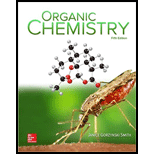
Concept explainers
(a)
Interpretation: The explanation corresponding to the given statement that the
Concept introduction: The
(b)
Interpretation: The explanation corresponding to the given statement that the
Concept introduction: The
Want to see the full answer?
Check out a sample textbook solution
Chapter 19 Solutions
Package: Organic Chemistry with Connect 2-year Access Card
- Arrange the following molecules in increasing order of acidity. Base it only on their structural differences and explain how it is so. 1. HF, CH3CH2CH2OH, CH3CH2COOH 2. Ethyl amine, Ethanol, Propanearrow_forwardPhthalic acid and isophthalic acid have protons on two carboxy groups that can be removed with base. (a) Explain why the pKa for loss of the rst proton (pKa1) is lower for phthalic acid than isophthalic acid. (b) Explain why the pKa for loss of the second proton (pKa2) is higher for phthalic acid than isophthalic acid.arrow_forwardPart 1. Choose the stronger acid in each pair of compounds. Part 2. Arrange the following compounds in order of increasing basicity. Part 3. Determine if the oxide is acidic or basearrow_forward
- Although it was initially sold as a rat poison, warfarin is an effective anticoagulant used to prevent blood clots. Label the most acidic proton in warfarin, and explain why its pKa is comparable to the pKa of a carboxylic acid.arrow_forwardWill acetylene react with sodium hydride according to the following equation to form a salt and hydrogen, H2? Using pKa values given in Table 4.1, calculate Keq for this equilibrium.arrow_forwardLow-molecular-weight dicarboxylic acids normally exhibit two different pKa values. Ionization of the first carboxyl group is easier than the second. This effect diminishes with molecular size, and for adipic acid and longer chain dicarboxylic acids, the two acid ionization constants differ by about one pK unit. Why do the two pKa values differ more for the shorter chain dicarboxylic acids than for the longer chain dicarboxylic acids?arrow_forward
- The following pKa values have been measured. Explain why a hydroxyl group in the para position decreases the acidity while a hydroxyl group in the meta position increases the acidity.arrow_forwardPhthalic acid and isophthalic acid have protons on two carboxy groupsthat can be removed with base. (a) Explain why the pKa for loss of thefirst proton (pKa1) is lower for phthalic acid than isophthalic acid. (b)Explain why the pKa for loss of the second proton (pKa2) is higher forphthalic acid than isophthalic acid.arrow_forwardArrange the following molecules in increasing order of acidity. Base it only on their structural differences and explain how it is so. 1. Butanoic acid, Propionic acid, Propylamine, Butanearrow_forward
 Organic ChemistryChemistryISBN:9781305580350Author:William H. Brown, Brent L. Iverson, Eric Anslyn, Christopher S. FootePublisher:Cengage Learning
Organic ChemistryChemistryISBN:9781305580350Author:William H. Brown, Brent L. Iverson, Eric Anslyn, Christopher S. FootePublisher:Cengage Learning

